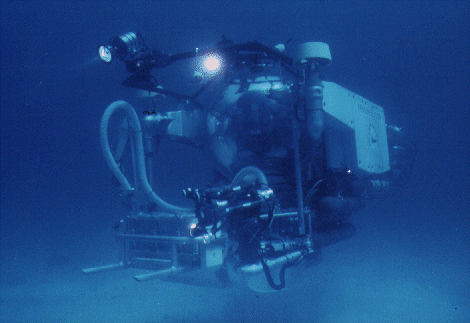
Two passengers--a pilot and a scientist --just fit in the Johnson Sea Link's pressure hull, a clear acrylic sphere 5 inches (13 cm) thick, and slightly less than 58 inches (1.5 m) in diameter. Divers wriggle in through an overhead hatch only 18.5 inches (47 cm) wide. During a three- to four-hour dive, things can really warm up. Acrylic is a good insulator, and heat from electronic equipment and the divers' bodies builds up in the cabin.
The Johnson Sea Link dives in the Bahamas, scouting cliffs down to depths of 3000 feet (914 m). Researchers observe marine life by peering through the thick acrylic sphere or through video cameras, and collect specimens using vacuum "slurpers" for delicate ones, jars that close after animals float or swim in, and robot-arms that scoop up rocks and hard-bodied organisms.
![]() The Harbor Branch Oceanographic Institution in Ft. Pierce,
Florida, owns and operates two
Johnson Sea Link
diving craft. Each submersible, carrying a pilot, two scientists, and a
technician, conducts about two hundred dives all over the world
every year.
The Harbor Branch Oceanographic Institution in Ft. Pierce,
Florida, owns and operates two
Johnson Sea Link
diving craft. Each submersible, carrying a pilot, two scientists, and a
technician, conducts about two hundred dives all over the world
every year.
 Specifications for the Johnson Sea-Link
Specifications for the Johnson Sea-Link
Size length 23.6 ft (7.2 m)
height 10.9 ft (3.1 m)
beam 8.3 ft (2.5 m)
Speed up to 1 knot, highly maneuverable
Gear lights, still and video cameras, manipulator arms,
suction devices, plankton samplers
Dive time usually less than 4 hours, life support back-up for 20
person-days
Missions mid- and deep-water observation, photography, dump-site
inspections, sea-floor sampling, searches and
recoveries, underwater archeology
Inventor Edwin Albert Link (1904-1981)
Additional submersible and submarine links
![]() Ocean Planet Exhibition Floorplan
Ocean Planet Exhibition Floorplan
![]()